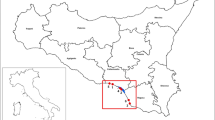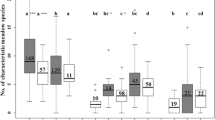Abstract
The vegetation of a 150 ha coastal dune area in the SW Netherlands was carefully analyzed and mapped at a scale of 1:2500 in 1959 and 1980. About 600 relevés were treated numerically. 127 vegetation types were distinguished, the overlap in community composition between the two years was very small. An intermediate level between this community level and the level of the structural-physiognomic formation was adopted. 56 so-called subformations, in which floristic and structural characters are combined, have been recognized and the overlap was then considerably larger, at least in number of types. Ordination results suggest that in each subset: grasslands, dune slacks, woodlands + scrubs, the first axis reflects floristic differentiation along with progression. The ordination of the entire material shows moisture as the main factor underlying the first axis, zonation as the second and nutrient status as the third factor.
Change in vegetation was detected through a network overlay with 2 300 points for each of which the transition between 1959 and 1980 was scored.
The pattern of change between 1959 and 1980 is apparently multiple pathway in type. This would be one of the few examples of such a pattern to be established on the medium term level of change, which is considered as succession sensu strictu. On an areal basis the change in vegetation is extremely large; even on the subformation level only 15% of the area was found to be unchanged, and on the community level only 4%.
The overall trend is progression with a strong increase in the area of tall scrubs and woodlands. Retrogression also occurs, partly as a result of disturbances such as fire, partly due to local death of a dominant woody species. This latter phenomenon is interpreted against the background of the starting point of the succession; a sudden release of the inner dune area from overgrazing by cattle and a subsequent rapid dune development (outer dunes) on the beach in front of the inner dunes.
Both species and community diversity increased, which is related to both differentiation under progression and to retrogression.
Similar content being viewed by others
References
Adriani, M. J. & Maarel, E. van der, 1968. Voorne in de branding. Stichting Wetenschappelijk Duinonderzoek Oostvoorne, 104 pp.
Arnolds, E. J. M. & Meijden, R.van der, 1976. Standaardlijst van de Nederlandse flora 1975. Rijksherbarium, Leiden. 26 pp.
Austin, M. P., 1977. Use of ordination and other multivariate descriptive methods to study succession. Vegetatio 35: 165–175.
Austin, M. P., 1980. An exploratory analysis of grassland dynamics: an example of a lawn succession. Vegetatio 43: 87–94.
Austin, M. P., 1981. Permanent quadrats: an interface for theory and practice. Vegetatio 46: 1–10.
Bakker, T. W. M., Klijn, J. A. & Zadelhoff, F. J.van, 1979. Duinen en duinvalleien, Pudoc, Wageningen, 201 pp.
Boerboom, J. H. A., 1960. De plantengemeenschappen van de Wassenaarse duinen. Thesis, Wageningen. Meded. Landbouwhogeschool Wageningen 60: 1–135.
Dietvorst, P., Maarel, E.van der & Putten, H.van der, 1982. A new approach to the minimal area of a plant community. Vegetatio 50: 77–91.
Drury, W. H. & Nisbet, I. C. T., 1973. Succession. J. Arnold Arbor. 54: 331–368.
Ellenberg, H., 1978. Zeigerwerte der Gefässpflanzen Mitteleuropas. 2. Aufl. Scripta Geobot Göttingen 9, 122 pp.
Grime, J. P., 1977. Evidence for the existence of three primary strategies in plants and its relevance to ecological and evolutionary theory. Am. Nat. 111: 1169–1194.
Grime, J. P., 1979. Plant strategies and vegetation processes. Wiley, Chichester. XII+222 pp.
Groenendael, J.van, Boot, R., Dorp, D.van & Rijntjes, J., 1982. De vestiging van Meidoornstruweel in duingrasland. Levende Natuur 84(1): 11–18.
Grubb, P. J., 1977. The maintenance of species richness in plant communities: the importance of the regeneration niche. Biol. Rev. 52: 107–145.
Hill, M. O., 1979. Decorana. A FORTRAN program for detrended correspondence analysis and reciprocal averaging. Ecology and Systematics, Cornell University, Ithaca. 52 pp.
Hill, M. O. & GauchJr., H. G., 1980. Detrended correspondence analysis, an improved ordination technique. Vegetatio 41: 47–58.
Jelgersma, S., Jong, J.de, Zagwijn, W. H. & Regteren Altena, J. F.van, 1970. The coastal dunes of the western Netherlands; geology, vegetational history and archaeology. Meded. Rijks Geol. Dienst NS 21: 93–167.
Küchler, A. W., 1974. Boundaries on vegetation maps. In: W. H.Sommer & R.Tüxen, (eds.), Tatsachen und Probleme der Grenzen in der Vegetation. Ber. Int. Symp. Ver. Vegetationskunde 1968, pp. 415–427. J. Cramer, Lehre.
Laan, D.van der, 1978. Fluctuations and successional changes in the vegetation of wet dune slacks on Voorne Phytocoenosis 7: 105–116.
Laan, D.van der, 1979. Spatial and temporal variation in the vegetation of dune slacks in relation to the ground water regime. Vegetatio 39: 43–51.
Londo, G., 1971. Pattern and process in dune slack vegetation along an excavated lake in the Kennemer dunes (the Netherlands). Thesis, Nijmegen. 279 pp.
Londo, G., 1974. Successive mapping of dune slack vegetation. Vegetatio 29: 51–61.
Loucks, O. L., 1962. Ordinating forest communities by means of environmental scalars and phytosociological indices. Ecol. Monogr. 32: 137–166.
Maarel, E. van der, 1960. Rapport inzake de vegetatie van het duingebied van de Stichting ‘Het Zuid-Hollands Landschap’ bij Oostvoorne. Delft. 57 pp.
Maarel, E.van der, 1966. Dutch studies on coastal sand dune vegetation, especially in the Delta region. Wentia 15: 47–82.
Maarel, E.van der, 1978. Experimental succession research in a coastal dune grassland. A preliminary report. Vegetatio 38: 21–28.
Maarel, E.van der, 1979a. Environmental management of coastal dunes in the Netherlands. In: R. L.Jefferies & A. J.Davy (eds.), Ecological Processes in Coastal Environments, pp. 543–570. Blackwell, Oxford.
Maarel, E.van der, 1979b. Multivariate methods in phytosociology, with reference to the Netherlands. In: M. J. A.Werger (ed.), The Study of Vegetation, pp. 161–225. Junk, The Hague.
Maarel, E. van der, 1980. Towards an ecological theory of nature management. In: W. Haber (ed.), Verh. Gesellschaft für Ökologie 9, Göttingen, pp. 13–24.
Maarel, E.van der, 1981. Fluctuations in a coastal dune grassland due to fluctuations in rainfall experimental evidence. Vegetatio 47: 259–265.
Maarel, E. van der, Cock, N. de & Wildt, E. de, 1984. Population dynamics of some major woody species in relation to longterm succession in the dunes of Voorne. Vegetatio (in press).
Maarel, E.van der, Janssen, J. G. M. & Louppen, J. M. W., 1978. TABORD, a program for structuring phytosociological tables. Vegetatio 38: 143–156.
Maarel, E.van der & Westhoff, V., 1964. The vegetation of the dunes near Oostvoorne. Wentia 12: 1–61.
Malmer, N., 1962. Studies on mire vegetation in the Archean area of southern Götaland. I. Vegetation and habitat conditions on the Åkhult mire. Opera Bot. Lund 7(1): 1–322.
Margadant, W., 1960. Mossentabel, 3rd ed. Amsterdam.
Miles, J., 1979. Vegetation Dynamics, Chapman & Hall, London. 80 pp.
Noble, I. R. & Slatyer, R. O., 1980. The use of vital attributes to predict successional changes in plant communities subject to recurrent disturbances. Vegetatio 43: 5–21.
Persson, S., 1981. Ecological indicator values as an aid in the interpretation of ordination diagrams. J. Ecol. 69: 71–84.
Roskam, E., 1971. Programme ORDINA: Multidimensional ordination of observation vectors. Programme Bull. 16, Psychology Lab. Nijmegen. 8 pp.
Sloet van Oldruitenborgh, C. J. M., 1976. Duinstruwelen in het Deltagebied. (in Dutch, with English summary). Thesis, Wageningen. Meded. Landbouwhogeschool Wageningen 76-8: 1–112.
Sloet van Oldruitenborgh, C. J. M. & Adriani, M. J., 1971. On the relation between vegetation and soil-development in duneshrub vegetation. Acta Bot. Neerl 20: 198–204.
Sloet van Oldruitenborgh, C. J. M. & Heeres, E., 1969. On the contribution of airborne salt to the gradient character of the Voorne dune area. Acta Bot. Neerl. 18: 315–324.
Tansley, A. G., 1949. The British Islands and their Vegetation, 2nd ed. Cambridge.
Tüxen, R. & Sommer, W.-H. (eds.), 1979. Gesellschaftsentwicklung (Syndynamics). Cramer, Vaduz. XV+502 pp.
Usher, M. B., 1980. Modelling ecological succession, with particular reference to Markovian models. Vegetatio 46: 11–18.
Walker, D., 1970. Direction and rate in some British postglacial hydroseres. In: D.Walker & R. G.West (eds.), Studies in the Vegetational History of The British Isles, pp. 117–139. Cambridge Univ. Press, Cambridge.
Walker, J., Thompson, C. H., Fergus, I. F. & Tunstall, B. R., 1981. Plant succession and soil development in coastal sand dunes of subtropical Eastern Australia. In: D. C.West, H. H.Shugart & D. B.Botkin (eds.), Forest Succession. Concepts and Applications, pp. 107–131. Springer, New York.
Westhoff, V. & Held, A. J.den, 1969. Plantengemeenschappen in Nederland. Thieme, Zutphen. 324 pp.
Westhoff, V. & Maarel, E.van der, 1978. The Braun-Blanquet approach. In: R. H.Whittaker (ed.), Classification of Plant Communities, 2nd ed., pp. 287–399. Junk, The Hague.
Whittaker, R. H., 1960. Vegetation of the Siskiyou Mountains, Oregon and California. Ecol. Monogr. 30: 279–338.
Whittaker, R. H., 1965. Dominance and diversity in land plant communities. Science 147: 250–260.
Whittaker, R. H., 1967. Gradient analysis of vegetation. Biol. Rev. 42: 207–264.
Whittaker, R. H., 1972. Convergences of ordination and classification. In: E.van derMaarel & R.Tüxen (eds.), Basic Problems and Methods in Phytosociology, pp. 39–57. Junk, The Hague.
Author information
Authors and Affiliations
Additional information
Nomenclature of phanerogams follows Arnolds & van der Meijden (1976), see Appendix 1 for some infraspecific taxa. Nomenclature of mosses follows Margadant (1960). For lichens see Appendix 1. Nomenclature of syntaxa follows Westhoff & den Held (1969). Basically the nomenclature is the same as in the earlier monograph on the area by van der Maarel & Westhoff (1964).
Research carried out 1980–1981 when the authors were at the Division of Geobotany, University of Nijmegen. We thank the Director of the Foundation Het Zuid-Hollands Landschap, owner of the dune area for providing facilities and a small grant for the fieldwork. Furthermore we thank Madeleine van Mansfelt, then ecologist at the Foundation. Help and hospitality at the Biological Station ‘Weevers’ Duin' of the Institute of Ecological Research, especially from P. van der Aart, J. van Groenendael and D. van der Laan, is also acknowledged. Computer programs were run at the IBM 370-158 system at the University of Nijmegen and the VAX 11-760 system of the Faculty of Science, University of Uppsala. We thank O. van Tongeren for help in Nijmegen and for comments on the manuscript. Finally we thank Märta Ekdahl for typing the manuscript.
Rights and permissions
About this article
Cite this article
van der Maarel, E., Boot, R., van Dorp, D. et al. Vegetation succession on the dunes near Oostvoorne, The Netherlands; a comparison of the vegetation in 1959 and 1980. Vegetatio 58, 137–187 (1985). https://doi.org/10.1007/BF00163874
Accepted:
Issue Date:
DOI: https://doi.org/10.1007/BF00163874




